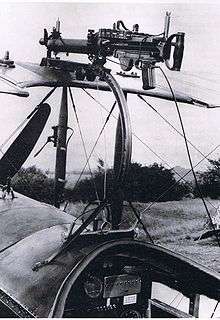Foster mounting

In early 1916 Sergeant Foster of No. 11 Squadron RFC devised a sliding rail mounting for the upper wing Lewis gun on a Nieuport 11. It enabled the gun to be pulled down so that its breech was conveniently in front of the pilot, making it much easier to change ammunition drums or to clear stoppages in flight. The mounting was readily adaptable to several other types of biplane fighter aircraft, including in particular the Nieuport 17 and 24 (in British service) and the S.E.5a, and became a standard fitting for these aircraft and others.[1]
Although possibly not part of the original intention the mounting allowed the Lewis gun to fire forwards and upwards, rather than straight ahead, to attack an enemy aircraft from behind and below, a favourite tactic of the ace Albert Ball and a precursor of the Schräge Musik tactics used by German night fighters in the Second World War. When fired directly forwards, the trigger of the Lewis gun was controlled by a Bowden cable; when fired upwards the pistol grip was held to steady the weapon, and it was fired by pressing the trigger.
Twin Foster mountings were occasionally used, although the recoil and vibration of two Lewis guns firing simultaneously was considered a dangerous strain for the lightly braced centre section of the aircraft of the time.
As the gun's line of fire was outside the propeller arc, Foster-mounted guns did not require synchronising gear. This was an advantage for the Lewis Gun, as its open bolt firing cycle could not be synchronised.[note 1]
The mounting could only be fitted to types with a suitable configuration, and was a little less stable and more subject to vibration than a mounting in the fuselage, resulting in a more widely spread pattern of fire.
The illustration shows a Foster mounting adapted to the Avro 504K night fighter. This aircraft had a much larger gap between the top of the fuselage and the upper wing than most types fitted with this type of mounting—in an S.E.5a for instance the gun was much more easily reached, and the mounting shorter and neater. A Lewis gun on a Foster mount was used to arm some night fighters as it was found that a synchronized Vickers gun could blind the pilot with its muzzle-flash.
See also
Notes
References
- ↑ Cheesman, E.F. (ed.) Fighter Aircraft of the 1914-1918 War. Letchworth, UK: Harleyford, 1960. P. 180
| ||||||||||||||||||